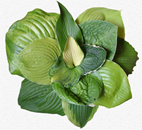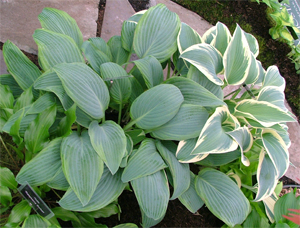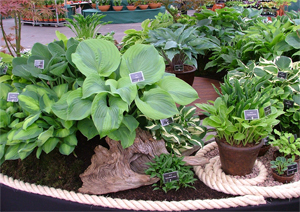Inspiring combinations
One of the
benefits of exhibiting Hosta at shows is to illustrate planting
combinations, and how you can create a wonderfully varied
border using just one genus.
Hosta borders
Herbaceous borders can take a lot of maintenance to keep them
looking lovely. If you grow a lot of Hosta together they
can look fabulous and, because there isn't the constant shedding
of decaying flowers and leaves, they naturally attract less
pests.
If you place a few jars on their sides with some slug
pellets in each, in the darkest recesses of the bed, you will
target any snails that do wander into the area. Beer traps
work quite well in these conditions but the smell can attract
more of a problem, rather like scattering pellets - use the
pellets in the jars, it works.
|
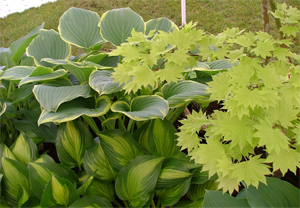 Malvern Spring
2012
Malvern Spring
2012 |
Also, if you have no love for the flowers, removing
them helps minimise the risk of attracting pests, and it tricks
the plants into thinking their season isn't yet over!
Replicating a natural environment
Hosta are woodland plants, naturally found growing on the lower
slopes of the mountains where they form the lower layer of vegetation.
Above them grow small trees, such as acers. These two images are
of acer 'Pixie' standing over Hosta in our 2012 Malvern
Spring display. This choice of red-leaved tree was made to mirror
the red stems of H.
'Fire Island' and H.
'Bedford Rise and Shine' planted underneath:
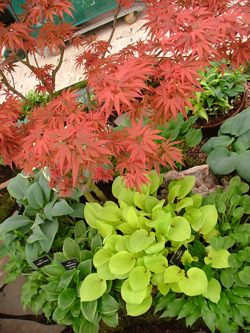 |
|
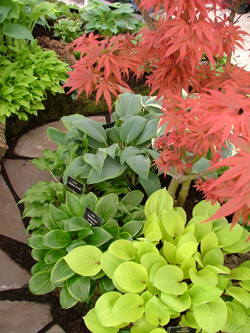 |
The dappled shade created by maples is excellent
for keeping the worse of the weather off your Hosta. However,
the biggest advantage of growing Hosta under trees is the fact
that they are constantly shedding decaying material. Woodland
floors are constantly littered with debris, which is what pests
feed on. It is the converse idea to the one mentioned previously,
but if you have too many pests they will also munch your fresh
vegetation. The answer to any pest problem is balance, because
the garden needs pests, as do the wildlife that predate on them.
However, too many pests and you will need to intervene with the
little glass jars.
Using similar types of plant
Some combinations work really well because the plants are related.
A particularly gratifying branch of the Hosta genus to play with
is the Tardiana group, which includes such favourites as H.
'June' and H.
'Touch of Class'.
Selecting different branches of the genus to display together
is something we like to do in Plant Heritage displays because
it helps illustrate the characteristics shared by those plants
more closely related to each other.
|
|
|
 |
Two Tardiana Group Hosta, H.
'Mourning Dove' and H.
'El Nino' are planted next to each other for the 2012 Malvern Spring show - complementing each other beautifully
|
|
|
In 2014 we experimented with spiral designs
of planting and used a selection of small and miniature varieties
to taper off the spiral mounds.
Here we used several varieties with
round leaves to carry through the theme: H. 'Shade Parade' , H. 'Blue Mouse Ears' and H. 'Vanilla Cream' complete the tip of the spiral.
These particular varieties would naturally remain in context with each other, size wise, over time. |
 |
The Royal Norfolk Show
2014 |
Good colour combinations
Despite the fact that these days there are so many colourful cultivars
to choose between, many people still consider all Hosta look the
same! We often stand bewildered when asked why this is the case,
but perhaps what is really meant is that they are so complimentary
no one variety stands out from another? You can be sure this comment
is even made whilst standing beside varieties so colourful, no other
foliage plant could come close - we are talking about H.
'Orange Marmalade' in its full spring glory!
 |
This
is a particularly lovely combination of plants with similar
leaf shapes but different textures and colours.
The glaucous matt blue leaves of
H. 'Deane's Dream' are surrounded clockwise from
the right by the bright chartreuse and cream leaves of
H. 'Sea Dream', the blue green leaves of
H. 'Blue Boy', the rich dark, shiny green leaves
of H.
'Devon Green', the chartreuse and blue-green variegation
of H.
'Katie Q', the glossy, wavy-edged leaves of H.
'Little Red Joy' and the beautiful variegation of H.
'Julie Morss'.
|
|
Gardeners' World
2012
|
From 2016 we moved to creating educational displays, which looked at different branches of the genus and highlighted specific species and cultivars responsible for its development over recent years. This involved group planting related plants to illustrate specific characteristics and it shows how they can still complement each other when similar.
All these displays have been captured on video, together with lists of the varieties used, via our video clips page.
Small scale
The rapid increase in the number of different small and miniature
varieties over recent years has opened up new possibilities for
gardeners, with much more modest spaces, to use Hosta in their
planting schemes. We like to pop these little gems into nooks and
crannies we create in our displays but sometimes they deserve a
stronger billing, like we did here, yet again at the 2012 Gardeners'
World show - opposite.
Here we planted clumps of H.
'Paradise Puppet', H.
'Lime Fizz',
H. 'Feather Boa' and H.
'Iced Lemon' around our slate sign - click on the image to view
larger.
|
|
Creating
drama - 'wow' planting combinations
We have some truly magnificent giant varieties, many originating
from H.
'Sum and Substance', which have dustbin-lid sized leaves
with a particular sheen that just grabs the eye.
This year
we used H.
'Titanic' at Gardeners' World and it stole the show. The
use of such a giant leaved variety among the detailed planting
surrounding throws the variety of the genus into sharp relief
- it certainly inspired visitors to the stand to try something
similar in their gardens, and there is a wealth of giant leaved
varieties to choose from.
H. 'Titanic' is underplanted with H.
'Vulcan' to the right, bog oak and H.
'Yakushima Mizu' in the foreground. |
|
Gardeners' World
2012
|
H.
'Captain Kirk' sits to the left underneath H.
'Fortunei Obscura' (H. 'Bella'), at the back of H. 'Titanic'.
A selection of pots sit in the coil of rope - simple but very
effective.
If any of our ideas inspire
you, don't forget you can select specific plants using our search
resource. Simply click on the dominant leaf colouring
you desire and those varieties with that leaf colouring
are listed in order of size, the variety links are colour-coded according to the flower colour. |
|

